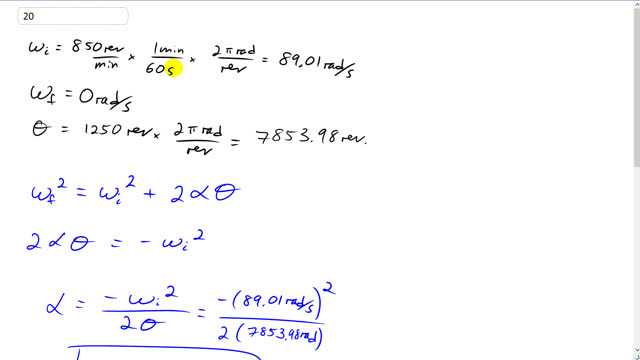
A cooling fan is turned off when it is running at 850 rev/min. It turns 1250 revolutions before it comes to a stop.
- What was the fan’s angular acceleration, assumed constant?
- How long did it take the fan to come to a complete stop?

In order to watch this solution you need to have a subscription.
This is Giancoli Answers with Mr. Dychko. Let's take care of some unit conversion first: we'll get the initial angular velocity of this cooling fan, convert it into radians per second by multiplying 850 revolutions per minute by 1 minute for every 60 seconds and multiply by 2π radians for every revolution and we get 89.01 radians per second. The final angular velocity is 0 because it comes to a stop and the total angular displacement is 1250 revolutions times 2π radians per revolution and we'll express this in radians, not revolutions here, by going 1250 times 2π and that gives 7853.98 radians, alrighty! So part (a) asks us for its angular acceleration and this is a formula that has all the things that we know and the only unknown being the angular acceleration. So the final angular velocity is 0 and we can subtract ω i squared from both sides and then switch the sides around and we get 2 times α times Θ is negative ω i squared. Then divide both sides by 2Θ and we get angular acceleration is negative of the angular velocity initial squared divided by 2 times angular displacement. And so that's negative 89.01 radians per second squared divided by 2 times 7853.98 radians which gives negative 0.50 radians per second squared. And then to find out how long this took, we'll use this formula— it's one of many that we could use; there's other formulas we could use that involve this angular acceleration but we are going to not use them because it's more strategic to choose a formula that uses only original data from the question rather than using some number that you calculated just in case your calculation has a mistake in it, you don't want that mistake to ruin the next part of the question. So we are gonna use this formula because it only has original data from the question, nothing that we have calculated. So angular displacement is average angular velocity times time and average angular velocity is the final plus the initial over 2— this is always true when you have constant acceleration— and the final angular velocity is zero and multiply both sides by 2 to get rid of the denominator 2 there and we get 2Θ is ω it, switch the sides around, divide by initial angular velocity and we get time is 2Θ over ω i. So that's 2 times 7853.98 radians divided by 89.01 radians and we get about 180 seconds when you round it to two significant figures.